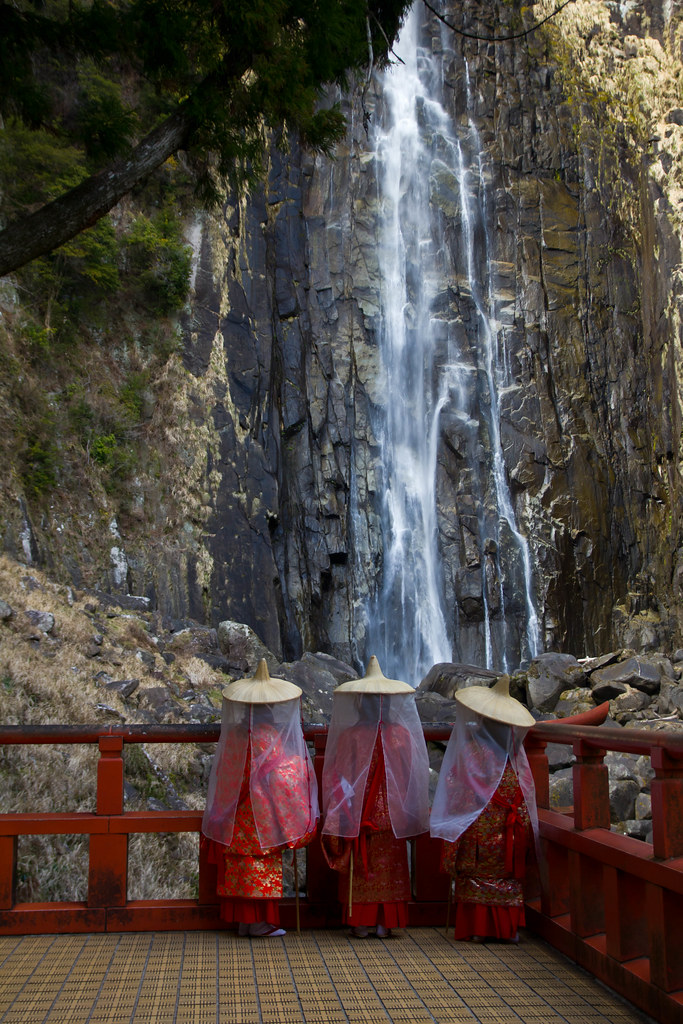#kumano sanzan
Text

The landscape of one of the three shrines of Kumano, a detail from "Illustrated Legends of the Origins of the Kumano Shrines" (熊野縁起絵巻), a set of handscrolls dating to the late 16th or early 17th century
El paisaje de uno de los tres santuarios de Kumano, un detalle de "Leyendas ilustradas sobre los orígenes de los santuarios de Kumano" (熊野縁起絵巻), un conjunto de pergaminos que datan de finales del siglo XVI o principios del siglo XVII
Image from the collection of the Metropolitan Museum of Art in New York
#japanese art#japanese literature#arte japonés#literatura japonesa#japanese religion#religión japonesa#絵巻#emaki#熊野三山#kumano sanzan#illuminated manuscript#manuscrito iluminado#熊野縁起絵巻#kumano engi emaki#鳥居#torii
26 notes
·
View notes
Text



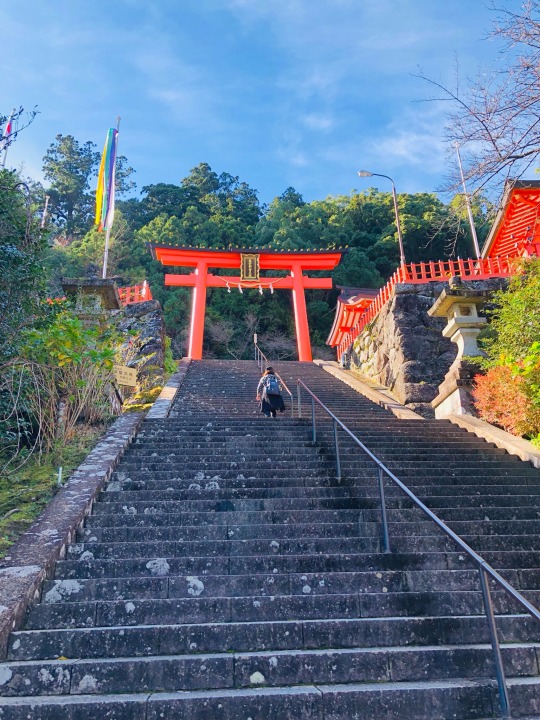




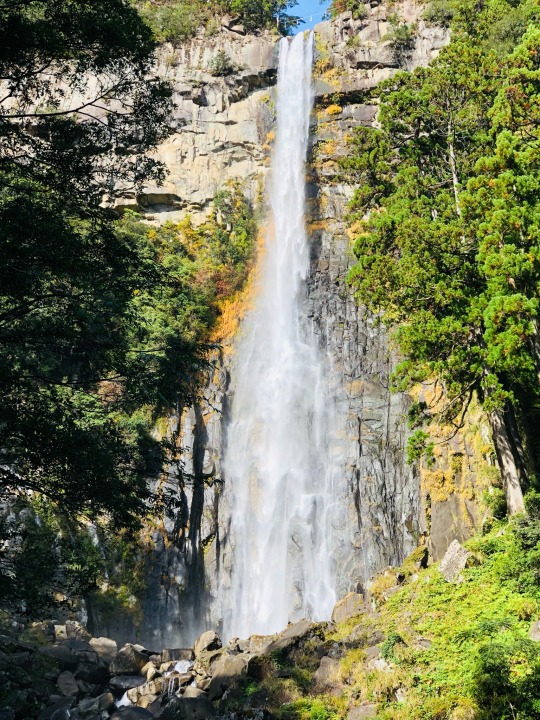

kumano sanzan | november 23-24, 2022
kumano hayatama taisha, kumano nachi taisha, seianto-ji, hiro jinja, nachi-no-otaki, kumano hongu taisha
>> read about it here <<
>> see all kumano posts <<
#mac.photo#jetsettermac#wakayama#nov22#kumano#kumano sanzan#kumano hayatama taisha#kumano nachi taisha#seianto ji#hiro jinja#nachi no taki#kumano hongu taisha
4 notes
·
View notes
Text
yamagata (part one)
So last October, my father and I rented a car and drove around Yamagata, Japan. We were there mostly because I'm a terrible little nerd and I really wanted to see the Dewa Sanzan, but we also stayed the night in an onsen town in the middle of a volcanic caldera.
The trip didn't go entirely to plan... I meant to have three days so we could more thoroughly explore the sacred mountains, but it ended up storming terribly for a couple days, so hiking... Not ideal...
I have mobility issues (and Dad was recovering from an injury) so I have to be pretty careful while doing stairs in the first place, so... doing it during a storm... It just wasn't going to happen. Still, though! We got to see a lot of cool things and we had a nice time.
Explanations and photos under the cut!
To begin with, the Dewa Sanzan are a set of three extremely sacred mountains in Yamagata Prefecture. The three mountains are Hagurosan, Gassan, and Yudonosan. That's also the order in which they're meant to be hiked, and each mountain increases in sacrality.
Which religion are they sacred to? Well... that's kind of a complicated question. When Buddhism came to Japan in the 6th century, it entered into a sort of (sometimes awkward) alliance with Shinto, the indigenous religion of Japan. (...more or less...)
You hear the term shinbutsu shūgō a lot around the mountains of Yamagata. Basically speaking, this refers to the syncretic religion created by combining elements of Shinto and Buddhism. There's another concept, honji suijaku, which explains how this was accomplished. The idea is that Buddhist deities were manifesting themselves on earth as Japanese kami, or the indigenous spirits that made up Shinto. In other words, the idea was that when Japanese people were seeing kami, they were actually seeing Buddhist deities who were disguising themselves in order to better spread the precepts of Buddhism.
These syncretic kami-buddha(/bodhisattva) pairs were called gongen. This part's important for where I'm going next.
This syncretic religion wasn't really cohesive or regulated throughout Japan. There wasn't one set list of sacred texts or one set person in charge to make rules, y'know? It spread around Japan largely organically, so there was a lot of variation in belief systems, rituals, etc. Some people would identify more with the Shinto side of things, some more with the Buddhist side.
What I was interested in, and why I went all the way out there, was a mountain ascetic religion called shugendō. Shugendō was a religion primarily practiced in the remote mountains of Japan, and it centered largely around the worship of gongen as well as submersing oneself in nature to meditate. It wasn't exactly easy to learn about where I went to school in Kyoto, so I jumped at the chance to rent a car and go see some mountains that were very sacred to shugendō practitioners, or yamabushi.
(I had originally also had us going to see the Kumano shrines in Wakayama, but after Dad got hurt, I cut a lot of walking out of the trip. So we chose Yamagata because you could drive right up to a lot of the shrines.)
Now, during the Meiji period, Shinto and Buddhism were forcibly separated by the government. (I won't get into the whys right now.) When that happened, a lot of syncretic sites were forced to either choose to be one or the other or be physically destroyed by the government. On Dewa Sanzan, most of the shugendō sites decided to convert to Shinto. It makes it kind of odd, when you're walking around a Shinto shrine that still clearly, clearly has a lot of Buddhist influence...
One of my big interests, when it comes to religious studies, is syncretic religions, so I've been wanting to learn more about all this for ages. But, due to the purposeful destruction of religious orders/sites as well as the remote locations... well, it's been hard. I was PUMPED to get out there.
lmao now that I've given you all a mini history lecture...
Yamagata!
Now, the first day, Dad and I rented a car in Yamagata City and drove out to Hijiori Onsen. It was really out in the middle of nowhere and honestly? Big Spirited Away vibes. I'm over here explaining the concept of kamikakushi to Dad and he is like. Not loving it.
Add to that the fact that it was raining and dreary and kind of awful, and the whole situation was just spooky.
Hijiori Onsen is also known for something in particular -- a thing that I forgot to tell dad about. They're known for making kokeshi dolls, which I guess explained.... uh. what we encountered on the drive up.
Oh? What's that in the distance?
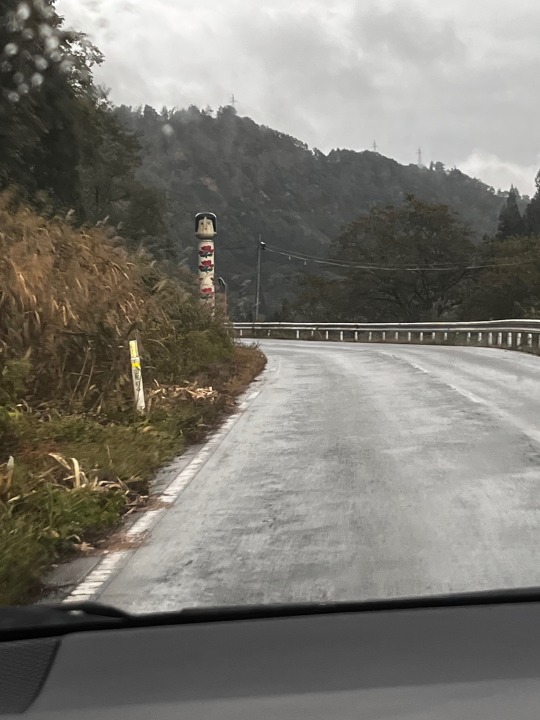
A giant, deeply creepy kokeshi?
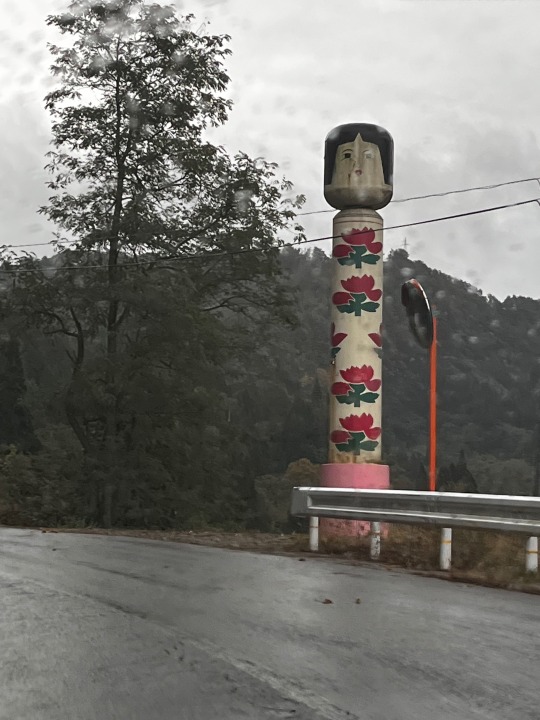
The terrible weather and empty countryside really did not make these things more reassuring.

I will be honest with you, the whole area kind of had Fatal Frame vibes lmao.
BUT when we finally made it to Hijiori Onsen, it was really lovely.
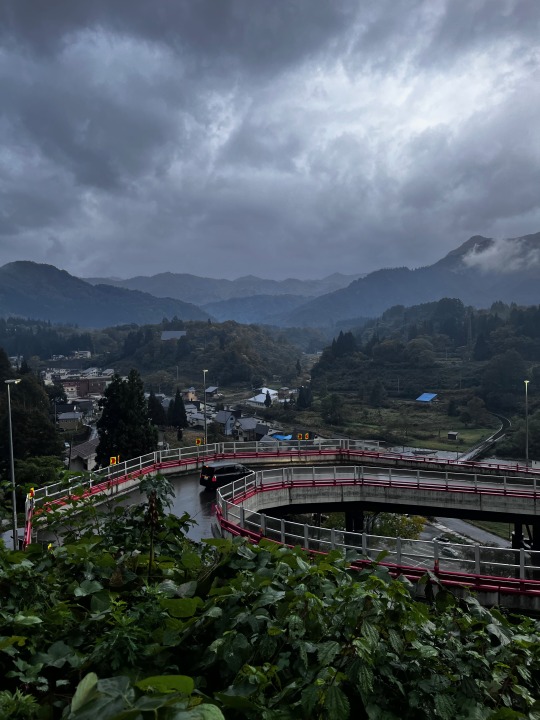
This was our ryokan, aka the only one that had an elevator and would allow my father's tattoos lmao.
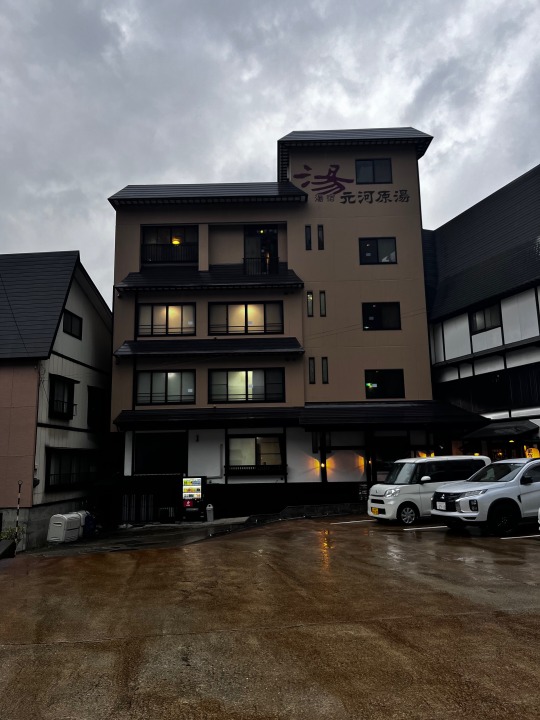
And oh look, more kokeshi. lmao

It was kind of fun to see the traditional fall decorations (the persimmons) next to more modern Halloween ones.
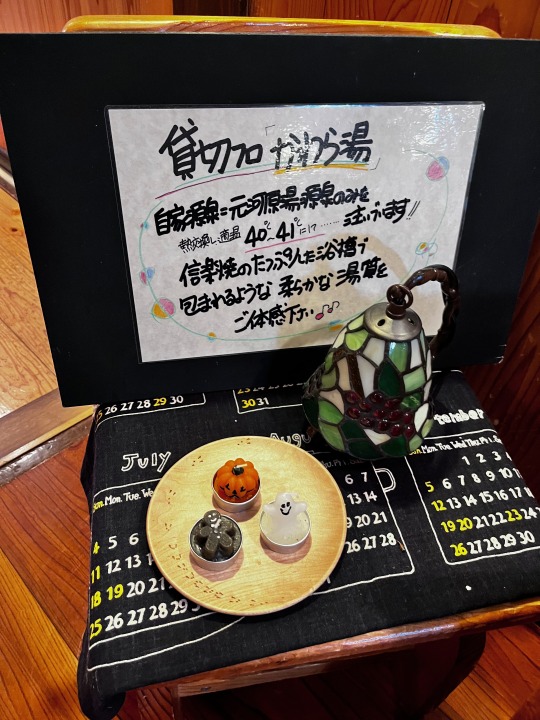
It was really lovely inside, though, and this was the view from our room.
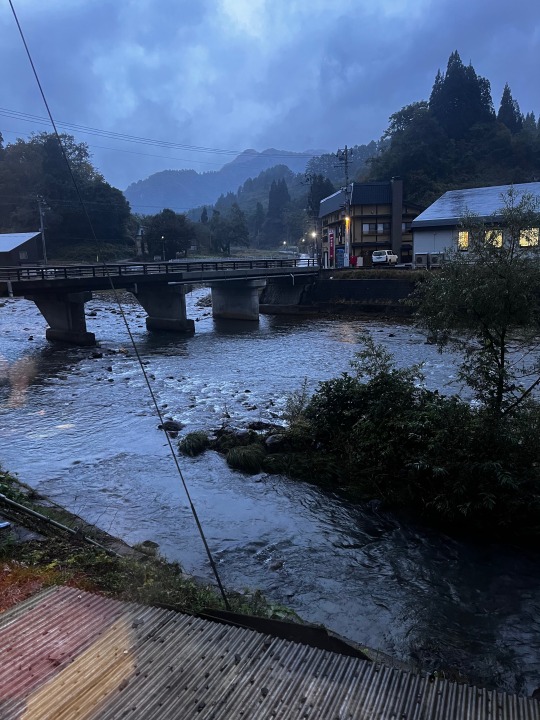
They also had a lot of local snacks, which was fun to try. (Pictured: apple cookies, green tea, and... I want to say candied burdock root?)
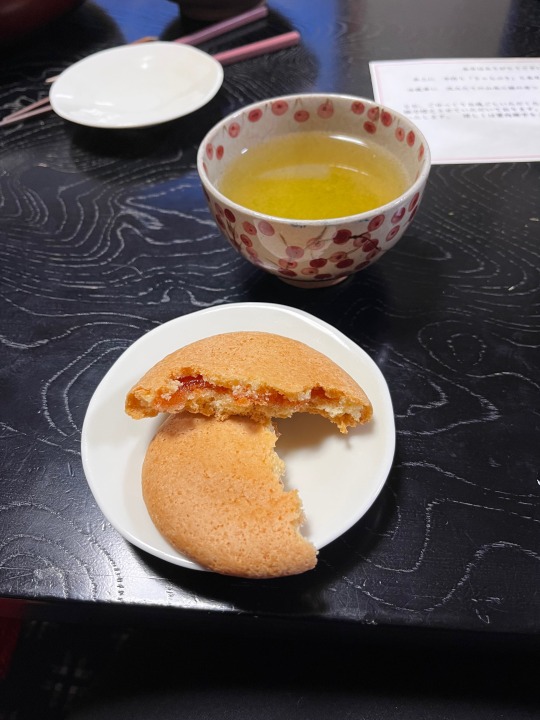
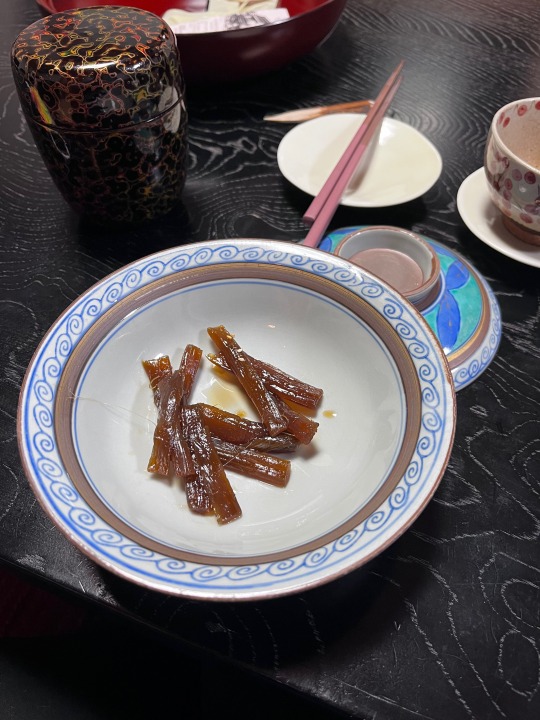
The food was a recurring theme, tbh. They fed us so much that my Dad was like no ;; please ;; we'll die ;;
More kokeshi, this time in the form of a chopsticks rest.
(Yes, I did buy myself one of their kokeshi at a shop in town before we left, lmao.)
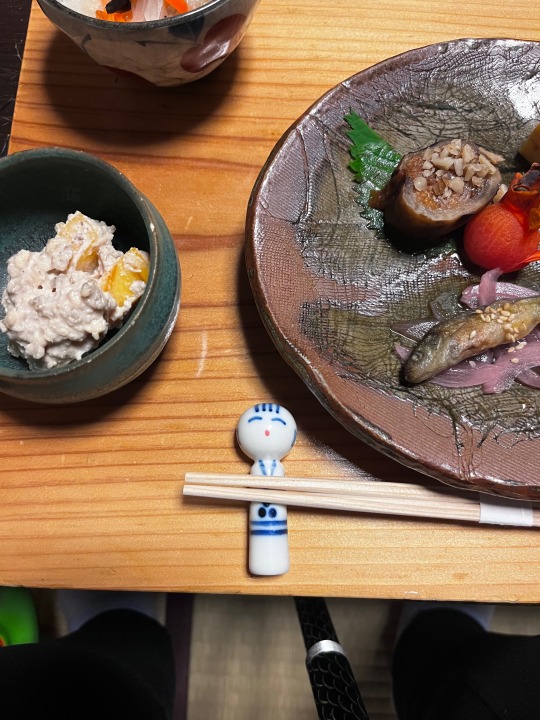
The dining room was pretty, with traditional braziers, soy sauce jars, etc.

Seriously, though, dinner lasted for like two hours and they must have brought dozens of little dishes.
They cooked the local beef and vegetables inside giant leaves, which was fun and tasted really nice. Kiritanpo rice balls... Sesame-crusted fish...
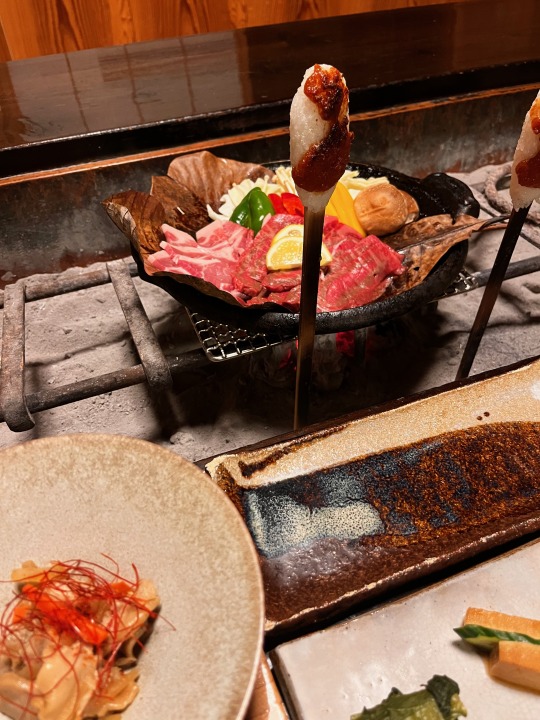
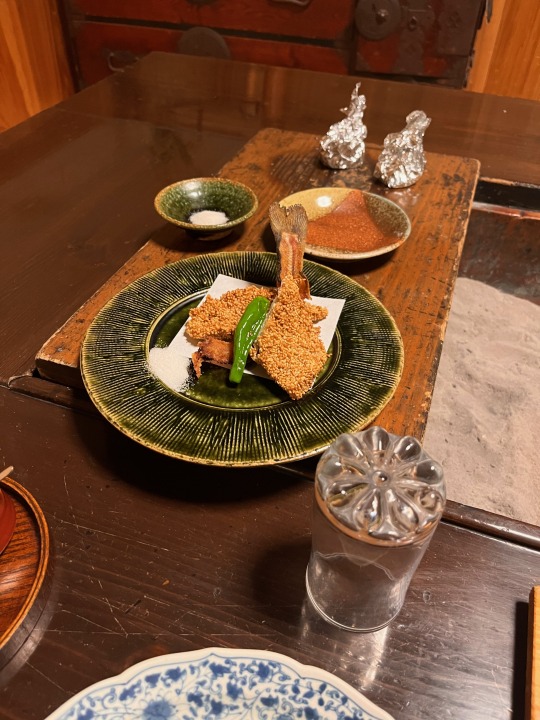
Even things I wasn't expecting to like as much, like the horse sashimi (🥲) and the fried fish bones were pretty good. (Honestly, horse is a little flavorless for me, but the fish bones were surprisingly good.)
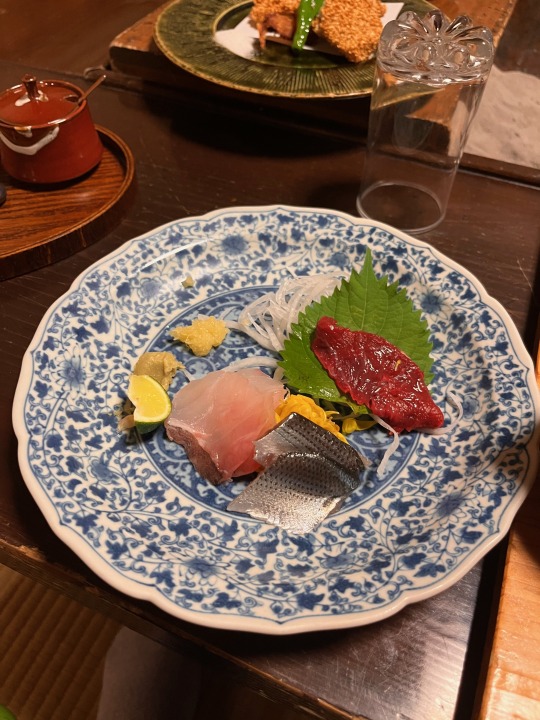
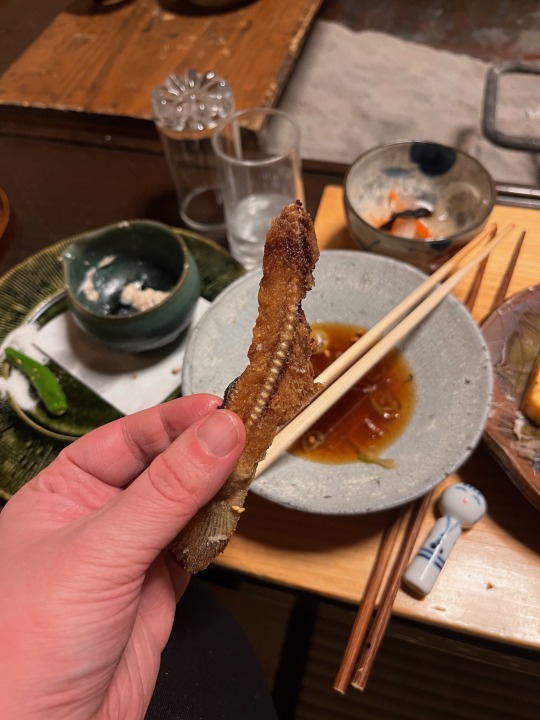
I won't show photos of everything (we'd be here all day) but one more highlight of dinner was the imoni, which is a sort of beef and taro hotpot they make in Yamagata in the fall. It was so good. ;; Tasted like sweet gyuudon with potatoes.

Also, I don't believe I got a photo of it, but when they were like "we have pumpkin :) :) for dessert :) :) happy halloween, americans!!!" I was like "omg, kabocha is my favorite, especially pudding!" and he was so excited, he was like YES, WE HAVE KABOCHA PUDDING! It was really cute.
(They seemed equally shocked and thrilled by my not-great Japanese. lmao. I think they'd had very low expectations of the weird Americans who'd come all the way out to Yamagata for reasons unknown to them.)
And after dinner, they brought a selection of local sake to my room to let me try, including some nigori sake, which is my favorite. It was so nice, even if we almost died from the sheer amount of food. They just kept BRINGING it lmao.
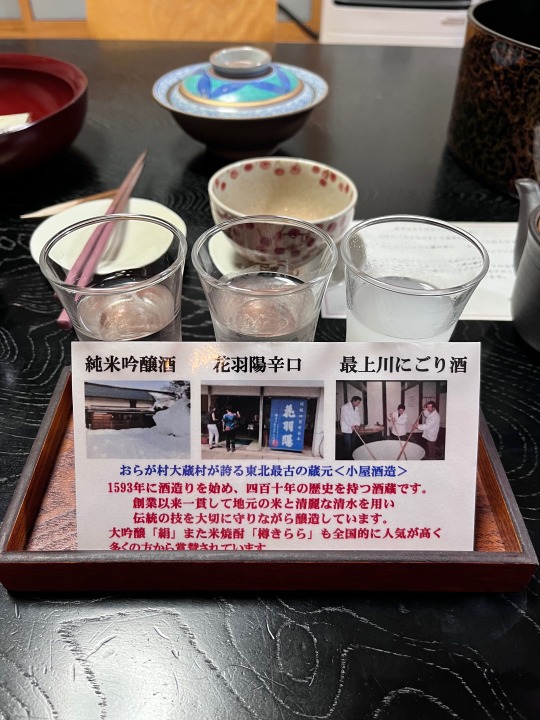
The baths there were also really nice, though obviously I couldn't take photos of those.
And this was the view from my window the next morning, once it was light out:

And breakfast, which was again far, far too much food. lmao
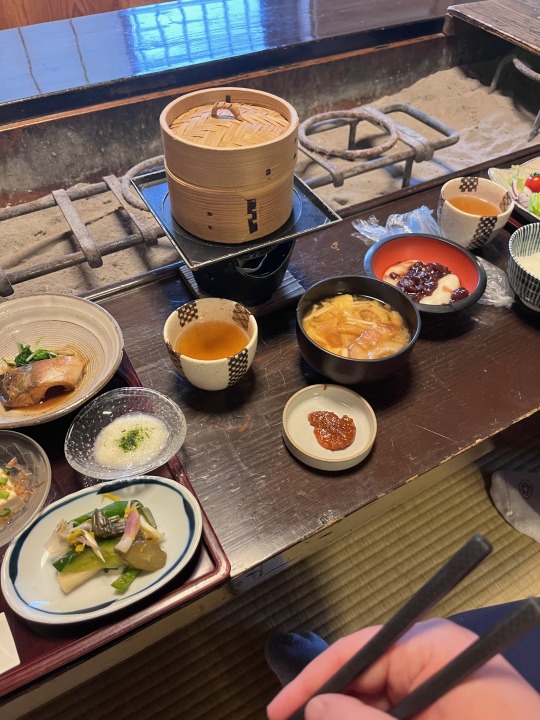
Then we drove around town a little. I forgot to take my phone with me when I got out of the car, like a dummy, so I didn't get great pictures of the tiny shopping district. I got myself a kokeshi, though, and got my father and I a box of karinto manju to split. (YES, I GOT THEM BECAUSE MY FROG GOT THEM FOR ME IN TABIKAERU, SO SUE ME. THEY WERE DELICIOUS.)
We then got extremely lost, but eventually stopped at the public baths. It was seriously pouring and it was cold and miserable so Dad just waited in the car while I took some short baths. Again, I can't show you photos of actual baths I took, but here are a few from online:


(Caldera Onsenkan)
This one was fun because it was naturally carbonated! They had hot and cold onsen you could bathe in. You couldn't really feel the carbonation in the hot onsen, but you sure could in the cold one. I put my feet in and was like "I am bathing in very, very cold soda" lmao.

(The cold bath for your hands and feet.)
And you could drink it, too! It was supposedly good for you! I only remembered weeks later that shugend�� monks were able to self-mummify (more on that later) in Yamagata because their natural spring water was so high in arsenic!
So uh hopefully that one doesn't come back to haunt me. lmao

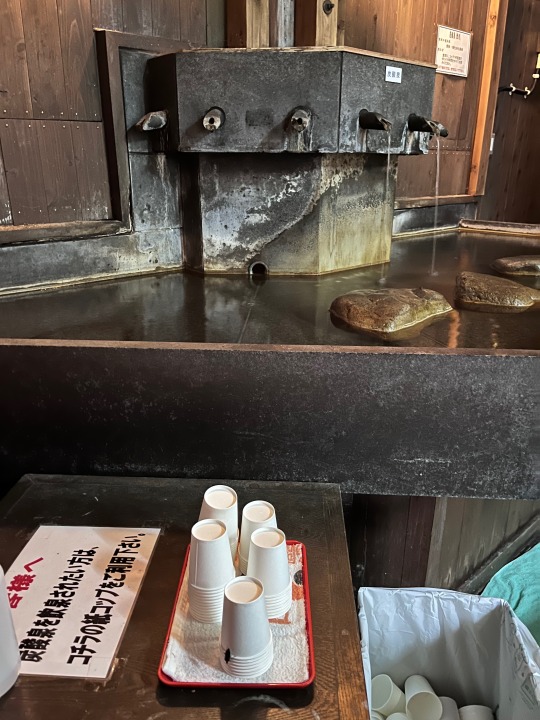
Watch out for the stinkbug.

There was another one in town that I was interested in, too... They say that Hijiori Onsen got its start as a medicinal hot spring town after a monk fell off a cliff and broke his elbow and then rolled into the hot spring and was instantly healed, and this was attributed to Jizo-sama.
So there's an onsen where Jizo will watch over you as you bathe.
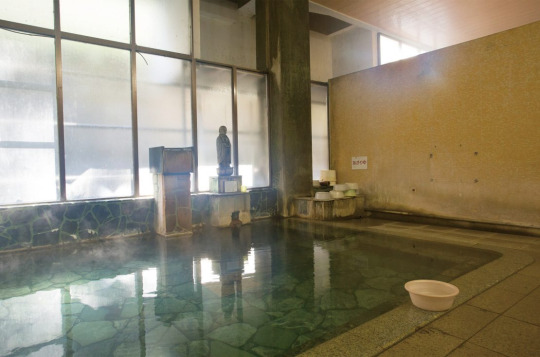
Which is fun, though I liked the similar experience in Kusatsu Onsen a little more. Gotta love a sacred bath, tho.
So then we left to go to the Dewa Sanzan. In the end, we ended up taking our time and stopping a lot at various shrines and stuff because I realized the weather was just too shitty to get a start on the mountains that day. Dad wouldn't even get out of the car except for lunch lmao. By the end of the day, it was hailing, so I can't really blame him.
The next leg of our trip will be in another post because I'm almost out of images in this one, but here's a couple more photos of Hijiori Onsen.

And two more for this round, we did get lost trying to get out of the caldera (...lmao) and broooo when I tell you my dumb ass was like "dad we are for SURE gonna get kamikakushi'd out here"
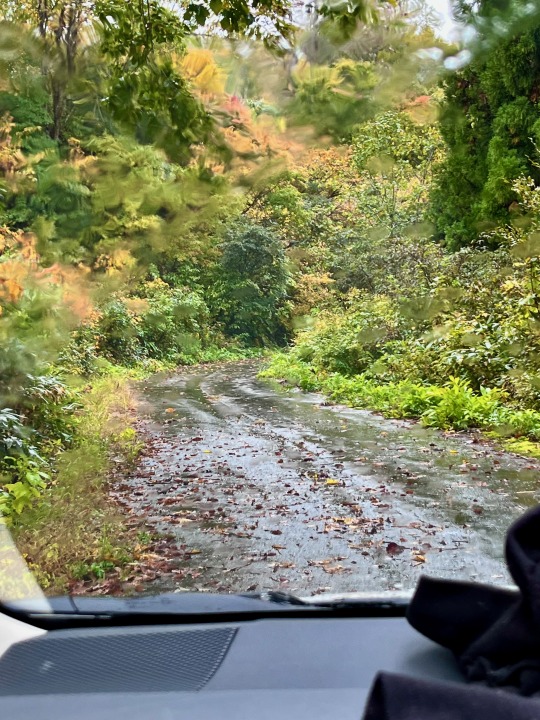
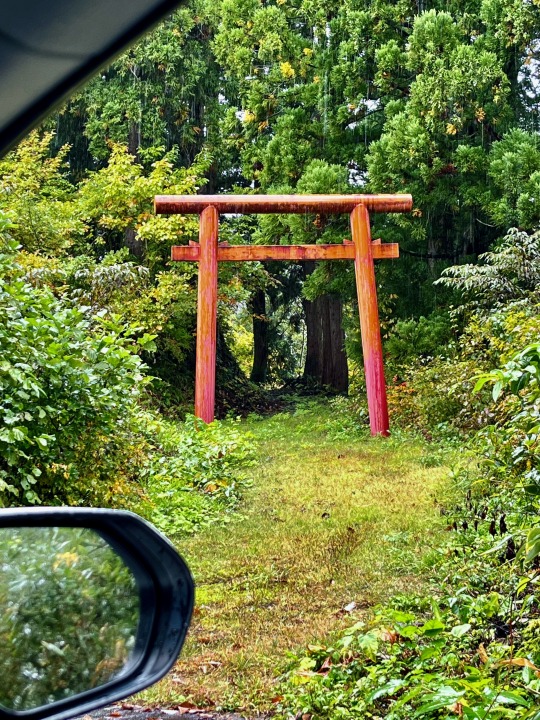
Tell me this doesn't feel like the beginning of a Miyazaki movie lmao.
(we lived, bitch!!! must've been all those sacred baths.)
12 notes
·
View notes
Text
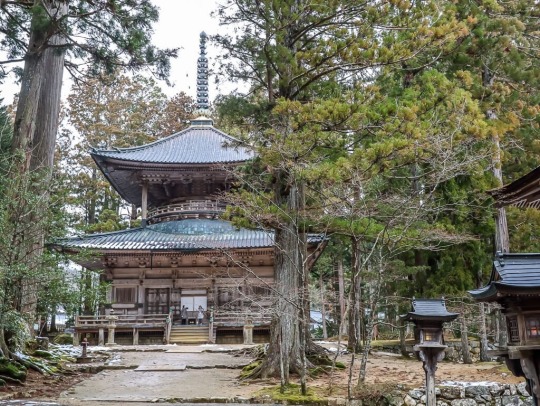
Koyasan - The Sacred Mountain of Shingon Buddhism
Nestled amidst the serene forests of the Kii Mountains in the north-eastern part of Wakayama Prefecture, south of Osaka, Koyasan, also known as Mount Koya, is a place of profound spiritual and historical significance. It is one of the three sacred sites, including Yoshino and Omine, and Kumano Sanzan, that are interconnected through ancient pilgrimage routes leading to the historic Japanese capital cities of Nara and Kyoto.
Koyasan is a place where time seems to stand still, where nature and spirituality blend seamlessly. This site is not merely a testament to religious devotion but also a reflection of the harmonious fusion of Shinto and Buddhism, two of Japan's most influential belief systems. Shinto, deeply rooted in Japan's ancient tradition of nature worship, coexists with Buddhism, introduced to Japan in the 6th century from China and the Korean Peninsula.
The origins of Koyasan's spiritual significance can be traced back to as early as the 9th century when several shrines were established, some predating the arrival of Buddhism in Japan. These shrines symbolize the rich tapestry of Japan's spiritual heritage and the coexistence of various belief systems over the centuries.
At the pinnacle of Koyasan stands Kongobuji, the principal temple of the esoteric Shingon Buddhist sect. Founded in 816 by the revered monk and scholar Kukai, also known as Kobo Daishi, this temple serves as the heart of spiritual practice in Koyasan. Kukai's vision transformed Koyasan into a sacred mountain for ascetic practitioners, and his legacy endures through the Shingon Buddhist tradition. Koyasan is home to a Designated National Treasure, featuring over 120 temples, each contributing to the spiritual ambiance and cultural significance of the area.
One of the most striking features of Koyasan is its Inner Sanctuary, which houses a vast cemetery, including the mausolea of many renowned figures in Japanese history. Among them is the final resting place of the 16th-century samurai ruler, Toyotomi Hideyoshi. This cemetery is not only a place of historical importance but also a testament to the enduring reverence for ancestors and the continuation of sacred traditions.
Koyasan is also marked by the grandeur of its Daimon Gate, which has stood as the main entrance to the temple complex since its inception. This gate, standing at a remarkable 25 meters in height, welcomes pilgrims and visitors alike, symbolizing the enduring spiritual journey that Koyasan represents.
Today, Koyasan continues to be an integral part of Japan's living culture. It is a place of deep spiritual connection and tranquility, attracting approximately 15 million visitors annually. The temple offers lodging facilities for pilgrims and visitors, allowing them to experience the serene ambiance of Koyasan and partake in its spiritual heritage.
In conclusion, Koyasan, with its rich history, spiritual significance, and cultural importance, stands as a testament to Japan's enduring reverence for the sacred and the coexistence of diverse belief systems. It is a place where the past seamlessly merges with the present, offering a unique and deeply enriching experience for all who visit.
13 notes
·
View notes
Text
Shinshi (Divine Servant)
The link did not include the chart, but I found one on the Japanese Wikipedia and machine translated it. The translation is below.
animal God
mouse Daikokuten
cow Tenmangu Shrine * See Tenjin Faith
tiger Chogosonshiji Temple
bee Futarasan Shrine
rabbit Sumiyoshi Taisha Shrine / Okazaki Shrine / Toshi Shrine
turtle Matsuo Taisha Shrine
crab Kotohira Shrine
eel Mishima Taisha Shrine
snake Benzaiten・
sea serpent Izumo Taisha Shrine
white snake Suwa Shrine Omiwa Shrine
fox Inari Shrine * See Inari God .
deer Kasuga Taisha Shrine / Kashima Shrine
monkey Hiyoshi Taisha Shrine / Asama Shrine
crow Kumano Sanzan , Itsukushima Shrine
crane Suwa Taisha Shrine
pigeon Hachiman Shrine
heron Kehi Shrine
chicken Ise Shrine , Atsuta Shrine , Isonokami Shrine
wolf Shrines in the Okutama / Chichibu region such as Musashi Mitake Shrine and Mitsumine Shrine
carp Omae Shrine
boar Go'o Shrine / Wake Shrine
centipede Bishamonten
Here is a link to the original text.
#Japanese Mythology#Animal#Shinshi#Divine Servant#Shinto#Mouse Spirit#Cow Spirit#Tiger Spirit#Bee Spirit#Rabbit Spirit#Turtle Spirit#Crab Spirit#Eel Spirit#Snake Spirit#Sea Serpant Spirit#Fox Spirit#Deer Spirit#Monkey Spirit#Crow Spirit#Crane Spirit#Pigeon Spirit#Heron Spirit#Chicken Spirit#Wolf Spirit#Carp Spirit#Boar Spirit#Centipede Spirit#Animal Spirit
4 notes
·
View notes
Photo
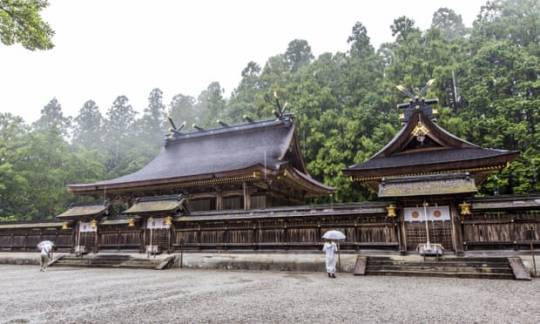
2018: Kumano Hongū Taisha is a Shinto shrine located in Tanabe, Wakayama, deep in the rugged mountains of the Kii Peninsula of Japan. It is included as part of the Kumano Sanzan in the World Heritage Site “Sacred Sites and Pilgrimage Routes in the Kii Mountain Range.”
Photograph: Alamy
4 notes
·
View notes
Text
THE KUMANO KODO TRAIL – AN ANCIENT JAPANESE PILGRIMAGE
One of our favourite walks, Explore Kumano Kodo, a UNESCO World Heritage Site, tucked into the mountainous Kii Peninsula and discover Japan’s rich history

What is the Kumano Kodo?
In the mountains of the Kii Peninsula is an area known as Kumano, where an ancient network of pilgrimage routes to the Kumano Sanzan shrines of Kumano Hongu Taisha, Kumano Hayatama Taisha, and Kumano Nachi Taisha are etched into the earth. Five prominent pilgrimages form the Kumano Kodo:
The Nakahechi Route
The Kohechi Route
The Ohechi Route
The Omine-Okugakemichi Route
The Iseji Route
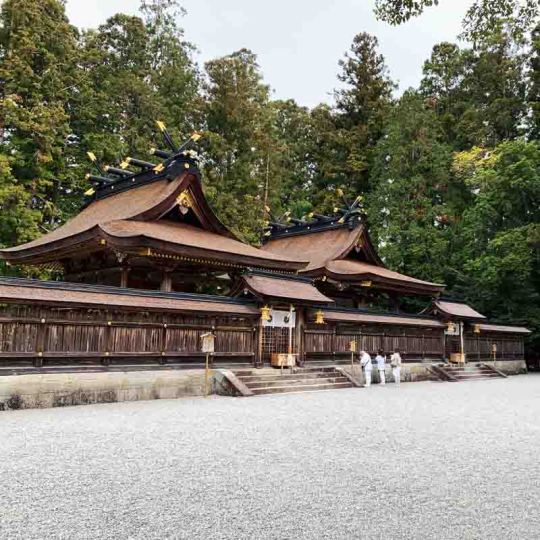
These pathways offer travellers an authentic experience of Japan as the locals welcome walkers into the region that showcases the island nation’s cultural roots. As you walk across the landscape, you will pass through small Japanese towns, beneath cedar trees, and across paths that follow the shoreline. Each pilgrimage is quite different from the others; some present more challenges, some are longer, and some have rare sights that can only be explored on foot.
History of the Kumano Kodo Pilgrimage Route
The route is considered to be one of the country’s most sacred trails.
During Japan’s formative years, the native religion of Shinto was formed, a way of life that worshipped the natural world and the sacred sites of Kumano. As Buddhism was introduced to Japan, the mountainous area became a training area for Buddhist monks. Eventually, Shintoism and Buddhism merged, creating a syncretic belief system. Over time, the Shinto deities were believed to be emanations of Buddha, and the monasteries became a place of worship.

For over a millennium, the routes became a pathway for those travelling to the Kumano shrines in search of spiritual enlightenment. These trails were crossed by emperors, the nobility and their families, and in later years by samurai warriors and then the people of Japan.
Seven things to expect on the Kumano Kodo
These sacred pathways are rich in history, with each route offering something different. If you have chosen to embark on the Kumano Kodo trail, here are a few things you can expect along the way:
The Kumano Kodo trail is open year-round, but there are ideal times to visit if you want to ensure the best hiking experience. We recommend you hike between April and November for the great weather this area enjoys.
Accommodation is available for hikers along the trail, from lodges to ryokans and minshukus. You must book accommodations before your arrival.
Being fluent in Japanese is appreciated but optional. Most directions and information about the trail are displayed in Japanese and English for international travellers.
Most of the accommodations along the trail have Wi-Fi access for guests.
You can access luggage shuttle services that will transport your belongings from your last accommodations stop to your next. These services are available when you are booking your Kumano Kodo trail, especially through an established service provider like Auswalk.
You have the option to hike the trail independently, guided or self-guided.
The guesthouses and ryokans that hikers stay at along the trail can provide meals during your walk, from dinners to packed lunches, as you make your way to the next town.
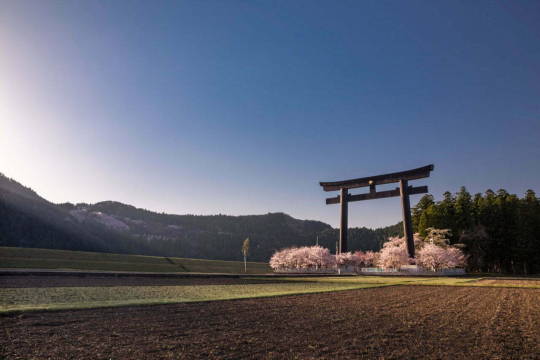
Essential Supplies for Kumano Kodo
If you are an avid hiker, you will know that there are essentials to every great hike to make the journey as comfortable and enjoyable as possible. Before walking on the Japanese mountainside, it is important to research and seek out information about supplies that locals and seasoned hikers suggest for this area.
Our research suggests a few essential items you won’t want to forget. Firstly, quality hiking boots. The terrain and duration along the trail can vary, and sturdy and supportive boots can make all the difference. We suggest wearing your boots before you leave to avoid any initial discomfort with new shoes.
Another valuable item is hiking poles. It can be challenging to climb up and down uneven paths, and the added stability will support you as you climb. Many hiking poles have a lightweight, compact design; therefore, they can fold down and be stored in your backpack in between use.
Next, invest in a good-quality backpack that is weather resistant, versatile, and includes a hydro pack for water. It is also essential to fill your backpack with a few bare necessities. A few practical items all hikers should carry include a first aid kit, weatherproof clothing, food, water, a flashlight, and a whistle. Other essentials may be toiletries, a camera, chargers, and clothing.
For those fortunate enough to walk the paths of the Kumano Kodo, take a moment to imagine the lives of those whose footsteps are etched into the earth in the same way yours will be when you leave this sacred place.

Is the Kumano Kodo like the Camino de Santiago?
Only two pilgrimage routes in the world are recognised as UNESCO World Heritage Sites—Kumano Kodo and Camino de Santiago.
There are a few differences, including distance. The Camino de Santiago covers 790 km, while the Kumano Kodo covers 68 km. The conditions are also very different, with the Kumano Kodo weaving through rugged mountain terrain and the Camino de Santiago predominantly winding through rural Spain ( and parts of Portugal and even France).
Is Kumano Kodo crowded?
The Kumano Kodo walk is a relatively quiet journey, with hikers occasionally crossing paths. Due to the limited trail accommodations, travellers can avoid large crowds.
Can you walk the Kumano Kodo trek solo?
Yes, hikers can trek Kumano Kodo by themselves. Booking accommodations at the lodges along the trail ensures that staff in the area are aware of your movements and can account for you at every stop. If you are looking for recommendations for walking companies for the Kumano Kodo trail we suggest Auswalk.
Is the Kumano Kodo a hard hike?
The Kumano Kodo hike offers many different paths, each of which is moderate to challenging. However, these trails vary in difficulty depending on the individual, so thoroughly research each before embarking.
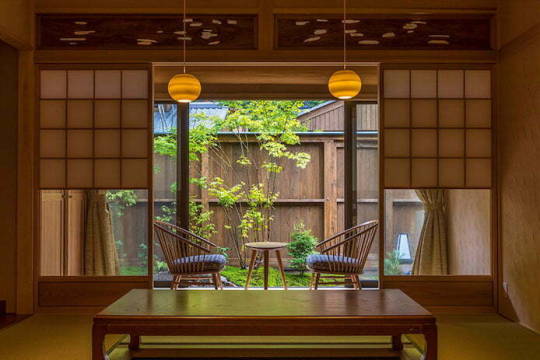
#trails#nature#photography#positivity#tours#groupguided#selfguided#kumano#kumano kodo#japan#japan destinations#japanese culture#japan trip#walking tour
1 note
·
View note
Photo



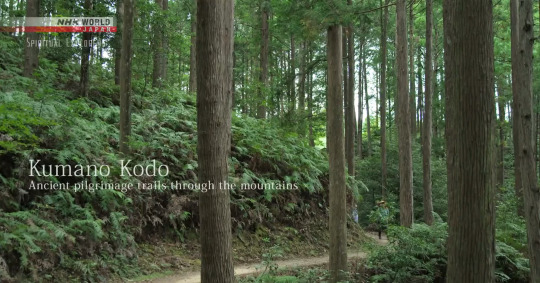

Kumano: Deities of Nature
“The West tries to analyze and understand, but the East tries to sense the divine.”
Long ago, a belief in animism, the idea that deities are present in every aspect of nature, existed throughout the world. This spirit lives on today in Kumano, a spiritual heartland of Japan. Why does nature continue to play such an important role in Japanese spirituality? We visit a trio of revered shrines in Kumano to explore the roots of Japanese animism.
#nhk world japan#kumano kodo#kumano#oyunohara#kii peninsula#wakayama prefecture#mie prefecture#kumano sanzan#japanese animism#kumano nachi taisha#kumano hayatama taisha#kumano hongu taisha#shinto#nature#animism#shintoism
19 notes
·
View notes
Video
Kumano Hayatama Taisha by rangaku1976
Via Flickr:
The Kumano Hayatama Taisha is a Shinto shrine located in Shingu, Wakayama Prefecture, on the shores of the Kumanogawa in the Kii Peninsula of Japan. It is included as part of the Kumano Sanzan in the UNESCO World Heritage site "Sacred Sites and Pilgrimage Routes in the Kii Mountain Range". The three Kumano Sanzan shrines are the Sōhonsha ("head shrines") of all Kumano shrines, lie at between 20 to 40 km of distance one from the other and are connected by the pilgrimage route known as "Kumano Sankeimichi". See also: www.tb-kumano.jp/en/world-heritage/kumano-hayatama-taisha/
#日本#Kii Peninsula#紀伊半島#Kii Hantō#紀伊山地の霊場と参詣道#Canon#Powershot#SX260#SX260 HS#Powershot SX260 HS#Canon Powershot SX260 HS#Kumano Kodo#Kumano Kodō#熊野古道#Kumano#Pilgrimage#Kumano Sanzan#熊野三山#Shinto#籠神社#Wakayama Prefecture#和歌山県#Wakayama-ken#UNESCO#Kiji#Nakahechi#注連縄#photography
1 note
·
View note
Photo


Kumano Hongu Taisha / 熊野本宮大社 - one of the three grand shrines on the Kumano Kodo Pilgrimage Route
Location: Tanabe, Wakayama
Address: Hongu, Hongu-cho, Tanabe-shi, Wakayama-ken / 和歌山県田辺市本宮町本宮
Website: http://www.hongutaisha.jp/english/
Map: https://www.google.com/maps/place/Kumano+Hong%C5%AB+Taisha/@33.8405324,135.7736192,15z/data=!4m5!3m4!1s0x0:0x70797ab0986aef02!8m2!3d33.8405324!4d135.7736192
#wakayama#kansai#tanabe#japan#shrine#shinto#religion#japanese#culture#sightseeing#july2018#kumano sanzan#kumano
0 notes
Text

The Nachi Fire Festival (那智の火祭り), also known as the Nachi Fan Festival (那智の扇祭り), at Kumano Nachi Taisha Shrine (熊野那智大社) in Nachi Katsuura, Wakayama Prefecture, held in full for the first time in four years
Photo from the shrine's official twitter account on July 14, 2023
#和歌山県#wakayama prefecture#那智勝浦町#nachikatsuura#熊野那智大社#kumano nachi taisha#祭り#祭#matsuri#festival#熊野三山#kumano sanzan
41 notes
·
View notes
Text




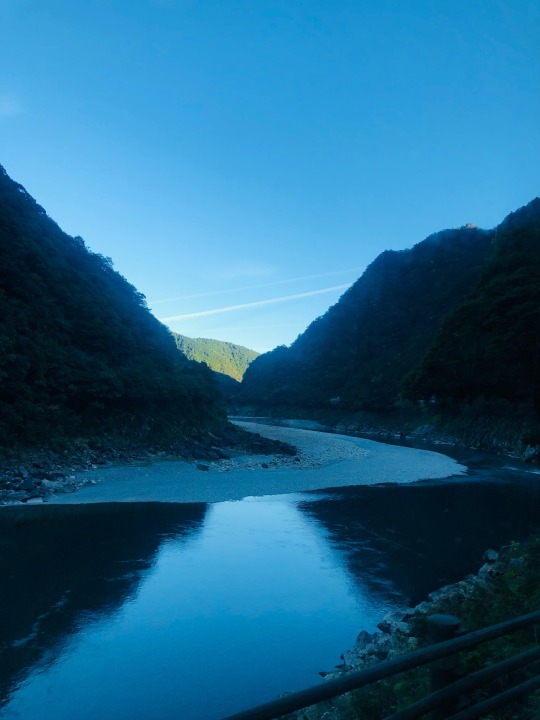

kumano kodo & kumano sanzan
november 23-26, 2022
>> see kumano sanzan photos <<
>> see kumano kodo posts <<
>> see all kumano posts <<
i completed the kumano kodo pilgrimage!
there are a few ways pilgrims can complete the pilgrimage. i chose visiting the kumano sanzan + walking from hosshinmon-oji to kumano hongu taisha. i’m not much of a hiker, so i figured this route is the most popular and a length that i can probably handle.
the first day was my date of arrival, so i dropped off my luggage and went to kumano hayatama taisha. i stayed in shingu, so it was just a short walk away. all of the kumano sanzan (the three holy sites of kumano) are dedicated to worshipping nature. hayatama is at the mouth of the kumano river and backed by the kii mountains, so nature is a very important aspect of worship at hayatama. i was able to receive my first kumano stamp and my goshuin there.
the second day i visited kumano nachi taisha, seianto-ji, hiro jinja, and nachi-no-taki. i was aware that it was located on a mountain and that a lot of climbing would be required, but my fitbit said i climbed 30 floors x__x like hayatama, nachi is dedicated to worshipping nature -- specifically the waterfall called nachi-no-taki. it is the highest waterfall in all of japan at 133 meters. seeing it in person was very awe-inspiring. i received my nachi and seianto-ji stamps for my kumano stamp book as well as goshuin from nachi, seianto-ji, and hiro.
the third day i walked the trail, starting off at hosshinmon-oji. oji are like mini shrines or subsidiaries of the main kumano shrines. hosshinmon-oji marks the outermost boundary of hongu’s precincts. hosshinmon-oji is one of the most important points of the kumano kodo and it means ‘gate to spiritual awakening and aspiration to enlightenment.’
next stopping point was mizunomi-oji. it’s a shrine with a water source. with the fall leaves being so colorful, it made for some nice photos. on the way to the next spot is a statue called domyuzenmon, erected in ancient times by nearby villagers to commemorate a monk in training who died just 100m from the next village. back in the day many people died trying to complete this pilgrimage.
next stop os fushiogami-oji. the name means to kneel and worship. going up a little lookout point, pilgrims would get their first glimpse of their final destination from here, and many fell down and prayed. apparently a famous female poet started to menstruate here. often people who were menstruating were not allowed because purity and whatnot but one of the kumano gods approached her and told her even gods suffer from impurities, so she was able to continue her pilgrimage. a bit further down is a gate i passed through that apparently served as a checkpoint. around this area is a scenic lookout of oyunohara, which is the site of the original hongu shrine and at which point now stands a giant torii gate.
next point was haraido-oji, where pilgrims purified themselves to prepare to enter the shrine.
finally we reached kumano hongu taisha from the back and collected the final stamp in the kumano kodo stamp book. kumano hongu taisha is the final of the kumano sanzan (three holy sites). after hongu i went on to oyunohara, where the shrine originally stood for 2000 years.
i met an old japanese man and his wife on the bus so i ended up walking with them. they were pretty nice to me considering how slow i was but im very grateful to them for walking with me. also met some americans! one girl has done both kumano kodo and santiago de compostela so she got a special ceremony.
this trip was basically two years in the making because of covid, and it’s something i thought would be a big challenge. i was right, it WAS very challenging. i’m pretty proud of myself for completing it!
#jetsettermac#mac.txt#mac.photo#wakayama#kumano#kumano kodo#kumano sanzan#kumano hayatama taisha#kumano nachi taisha#kumano hongu taisha#hosshinmon oji#mizunomi oji#fushiogami oji#haraido oji#oyunohara#nov22
1 note
·
View note
Video
Nachi Falls by neilbruder
Via Flickr
#shrine#Shinto#Japan#kii Peninsula#Kumano Kodo#Unesco#Unesco World Heritage Site#Kumano Nachi Taisha#waterfall#Kumano Sanzan#Nachi Falls#geo:lat=33.672604#geo:lon=135.889463#geotagged
2 notes
·
View notes
Text
Shinrin-yoku: văn hóa "tắm rừng" ở Nhật Bản
"Shinrin-yoku" trong tiếng Nhật có nghĩa là “đắm mình vào không gian rừng” hay “tắm rừng”. Đây không phải là bài tập thể dục đi bộ hay chạy bộ đường dài, mà chỉ đơn giản là đón nhận và kết nối với thiên nhiên bằng khứu giác, vị giác, thị giác, thính giác và xúc giác, bằng cách hít ngửi hương rừng, thưởng thức không khí trong lành, ngắm nhìn cây lá thay màu, lắng nghe tiếng chim hót, tiếng suối chảy róc rách, chạm vào lớp rêu xanh mượt, những viên đá nhẵn bóng hay vỏ cây xù xì và cảm nhận làn gió mơn trớn trên làn da. Và khi các giác quan được mở ra, chúng ta bắt đầu kết nối với thế giới tự nhiên.

Từ những năm 1980, Chính phủ Nhật Bản dần nhận thấy những tác động bất lợi do sự bùng nổ công nghệ đối với người dân đô thị như trầm cảm, mất tập trung, đau nhức cơ thể... Thành phố đông đúc không phải là nơi thư giãn thực sự, thay vào đó, chỉ những khu rừng mang lại cảm giác bình yên. Do đó, vào năm 1982, Bộ Lâm nghiệp Nhật Bản đã cho ra đời cụm từ "shinrin-yoku" nhằm khuyến khích người dân kết nối với tự nhiên bằng liệu pháp sức khỏe đặc biệt này. Qua trải nghiệm về lại rừng xanh, con người không những được nâng cao thể chất mà còn được cải thiện cả sức khoẻ tinh thần. Hiện nay, loại hình này lan rộng và được ưa chuộng không chỉ ở Nhật Bản mà còn ở các nước như Mỹ, Hàn Quốc và Đài Loan.

Trên khắp Nhật Bản đều có các trung tâm chuyên về liệu pháp shinrin-yoku, sẵn sàng cung cấp các tour du lịch có tổ chức dựa trên nhu cầu cá nhân của du khách. Với sự trợ giúp của hướng dẫn viên hoặc nhà trị liệu, du khách sẽ học cách sống chậm lại và tận hưởng thiên nhiên xung quanh, và có thể kết thúc liệu trình shinrin-yoku bằng một buổi trà đạo.

Nếu du khách muốn tự mình "tắm rừng", những công viên quốc gia tuyệt đẹp sẽ là điểm đến hoàn hảo. Nếu muốn đi bộ đường dài, du khách có thể đến dãy núi Alps Nhật Bản - bao gồm ba dãy núi ở vùng Chubu trên đảo Honshu với khí hậu tương tự như dãy Alps của châu Âu - kéo dài từ tỉnh Toyama đến tỉnh Shizuoka. Trên dãy Alps Nhật Bản, có một số đỉnh núi cao trên 3.000 m như đỉnh Kita (3.193 m), đỉnh Hotaka (3.190 m), và đỉnh Ontake (3.067m) - một núi lửa còn hoạt động.


Nếu thiên về đi hành hương tâm linh, hãy đến Kii, bán đảo lớn nhất trên đảo Honshu của Nhật Bản, nằm về phía nam Osaka. Tại đây, du khách có thể trải nghiệm "tắm rừng" ở vườn quốc gia nổi tiếng Yoshino-Kumano rộng hơn 61.400 ha, với cảnh quan đa dạng như núi, sông, biển... và cả những tuyến đường mòn hành hương linh thiêng. Kumano Sanzan là tên bộ ba đền lớn nằm về phía đông nam bán đảo Kii, gồm Kumano Hongu Taisha, Kumano Hayatama Taisha và Kumano Nachi Taisha.

Những ai đam mê mạo hiểm thì có thể đi về phía nam đến Vườn Quốc gia Yakushima nằm trên đảo cùng tên, thuộc tỉnh Kagoshima, phía cực nam đảo Kyushu và khám phá nguồn cảm hứng cho Công chúa Mononoke của Studio Ghibli. Yakushima vốn là đảo cận nhiệt đới, hình dáng gần như một chấm tròn, nổi tiếng với những đỉnh núi cao nhất vùng Kyushu, cũng là quê hương của những cây tuyết tùng cổ xưa cả nghìn năm tuổi, lâu đời nhất đất nước. Nơi đây được coi là một trong những địa điểm "tắm rừng" lý tưởng nhất. Năm 1993, đảo Yakushima được UNESCO công nhận là Di sản Thiên nhiên thế giới. Hồ sơ di sản của UNESCO cho biết đây là nơi sinh sống của 1.900 loài và phân loài thực vật, 16 loài động vật có vú, 150 loài chim.
2 notes
·
View notes
Text



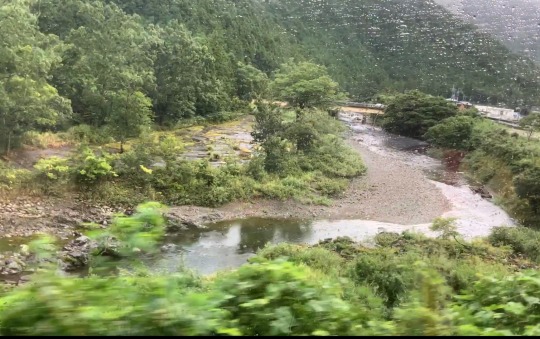






I have just been to the shrines of Kumano Sanzan (mountains )in Wakayama prefecture.
It takes 6 hours from Tokyo if you get on the fastest Shinkansen. This was the first time for me to visit the historical old place Kumano.
I was very excited and moved.
9 notes
·
View notes
Photo

南陽市熊野大社 Kumano Taisha Shrine,Nanyo City

不思議な直線上に存在する古い神社群の巻
Shrine on the mysterious straight line.

昔投稿した地元のいくつかの古い神社が直線上に並んでいる不思議の件ですが(link)、奇妙な事に、遠く離れて一見関係のないこの熊野大社もまたその謎の直線上に存在してるようです、ちょうど月山を挟んだ形になっていますね。
as i posted it two years ago, in my hometown,some old shrine buildings(”Oomono Imi” shrine,”Asuka” Shrine,”Dewa Sanzan” Shrine and Mt.gassan Shrine) are positioned on the mysterious straight line.(link)
interestingly,their shrines and this shrine “Kumano Taisha” are connected by mysterious straight line too.i dont know why.
59 notes
·
View notes
